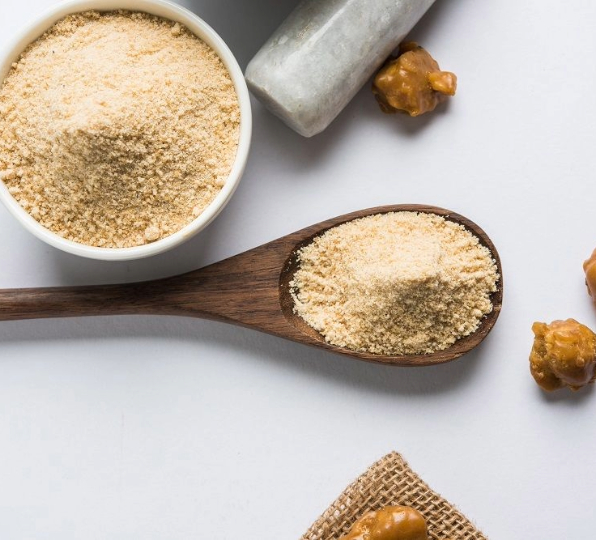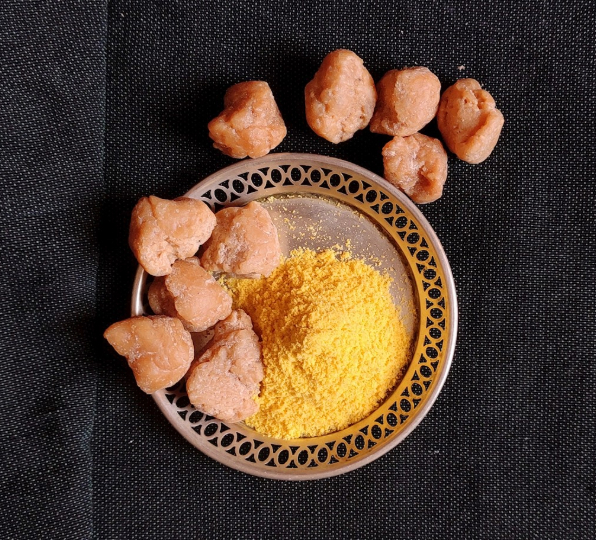Introduction:
Asafoetida, another name for hing, is a powerful spice made from the resin of the Ferula plant. Hing has been used extensively in Indian cooking for centuries due to its unique flavor and aroma. It also has a long list of remarkable health advantages. We’ll look at five strong arguments for including hing in your diet in this blog, along with some information on its health benefits and culinary applications.
1. Digestive Aid
Hing, also known as asafoetida, has held a significant place in traditional medicine for centuries, revered for its potent digestive properties. Widely used in culinary practices and herbal remedies, hing has been recognized for its ability to provide relief from various digestive ailments, including indigestion, gas, bloating, and stomach discomfort. The active compounds found in hing, such as ferulic acid and umbelliferone, contribute to its digestive benefits by stimulating the production of digestive enzymes, thereby promoting efficient digestion and alleviating gastrointestinal issues.
Indigestion, characterized by discomfort or pain in the upper abdomen, often results from impaired digestion or slow movement of food through the digestive tract. Hing’s digestive enzymes enhance the breakdown of carbohydrates, proteins, and fats, facilitating smoother digestion and reducing the likelihood of indigestion. By aiding in the digestion process, hing helps prevent the accumulation of undigested food particles in the digestive system, which can lead to discomfort and bloating.
Gas and bloating are common digestive complaints that can result from the fermentation of undigested carbohydrates in the gut. Hing’s ability to stimulate digestive enzyme production helps improve the breakdown of carbohydrates, reducing the fermentation process and minimizing gas production. Additionally, hing possesses carminative properties, which help alleviate gas by promoting the expulsion of trapped gases from the digestive tract, providing relief from bloating and discomfort.
Stomach discomfort, including cramps, spasms, and general discomfort, can often be attributed to poor digestion or irregular bowel movements. Hing’s digestive properties help regulate bowel movements and promote regularity, reducing the likelihood of stomach discomfort associated with constipation or irregularity. By enhancing digestion and promoting intestinal motility, hing supports overall digestive health and contributes to a more comfortable gastrointestinal experience.
Incorporating hing into your culinary repertoire can be a simple yet effective way to reap its digestive benefits. Adding a pinch of hing to dishes such as lentils, beans, vegetables, or legumes can enhance their digestibility and minimize the risk of digestive discomfort. Similarly, incorporating hing into spice blends or seasoning mixes can impart its digestive properties to a wide range of dishes, making it a valuable addition to any kitchen.
2. Anti-inflammatory Effects
Hing, commonly known as asafoetida, has long been prized in traditional medicine for its remarkable anti-inflammatory properties, which have been harnessed to address a variety of inflammatory conditions afflicting individuals worldwide. From arthritis to asthma and inflammatory bowel diseases, hing’s potent anti-inflammatory effects offer relief from pain, swelling, and discomfort, improving overall well-being and quality of life.
Inflammatory conditions are characterized by an abnormal immune response that leads to tissue damage, pain, and swelling. Hing exerts its anti-inflammatory effects by inhibiting the production of pro-inflammatory compounds, including cytokines, leukotrienes, and prostaglandins. By modulating the inflammatory response at the cellular level, hing helps mitigate the cascade of inflammatory processes that contribute to tissue damage and pain.
Arthritis, a common inflammatory joint disorder, is marked by inflammation of the joints, resulting in pain, stiffness, and reduced mobility. Hing’s anti-inflammatory properties help alleviate symptoms of arthritis by reducing joint inflammation and swelling, thereby improving joint function and enhancing mobility. Regular consumption of hing may offer relief from arthritic pain and stiffness, promoting better joint health and overall quality of life.
Asthma, a chronic inflammatory respiratory condition, is characterized by airway inflammation and bronchoconstriction, leading to breathing difficulties and respiratory distress. Hing’s anti-inflammatory effects can help alleviate asthma symptoms by reducing airway inflammation and improving bronchodilation, thereby facilitating easier breathing and reducing the frequency and severity of asthma attacks.
Inflammatory bowel diseases (IBD), including Crohn’s disease and ulcerative colitis, are chronic inflammatory conditions of the gastrointestinal tract characterized by inflammation and tissue damage. Hing’s anti-inflammatory properties offer relief from IBD symptoms by reducing intestinal inflammation and promoting gut health. By mitigating inflammation in the digestive tract, hing helps alleviate symptoms such as abdominal pain, diarrhea, and rectal bleeding, improving overall digestive function and quality of life for individuals with IBD.
Incorporating hing into your daily diet or utilizing it in herbal remedies can provide a natural and effective approach to managing inflammatory conditions. Adding a pinch of hing to cooked dishes, soups, or curries can impart its anti-inflammatory benefits to meals, while hing supplements or tinctures offer concentrated doses for targeted relief.
3.Respiratory Health Support
In traditional Ayurvedic medicine, hing, also known as asafoetida, has been revered for its therapeutic effects on respiratory health, offering relief from a variety of common respiratory ailments including coughs, colds, and bronchitis. With its potent expectorant properties, hing helps to alleviate respiratory symptoms by facilitating the removal of excess mucus and phlegm from the respiratory tract, promoting clearer breathing and providing relief from congestion.
Respiratory conditions such as coughs and colds are often accompanied by excessive mucus production and congestion, leading to discomfort and difficulty breathing. Hing acts as an expectorant, meaning it helps to thin and loosen mucus, making it easier to expel from the respiratory passages. By promoting the expulsion of mucus and phlegm, hing helps to clear congestion and alleviate respiratory symptoms such as coughing, wheezing, and chest tightness, allowing individuals to breathe more comfortably.
Bronchitis, an inflammatory condition of the bronchial tubes characterized by coughing, chest congestion, and difficulty breathing, can also benefit from the expectorant properties of hing. By thinning mucus secretions and promoting their elimination from the airways, hing helps to alleviate bronchial congestion and reduce cough severity, providing relief from bronchitis symptoms and promoting faster recovery.
In addition to its expectorant properties, hing also exhibits antimicrobial and anti-inflammatory effects, further supporting respiratory health and combating infections. Its antimicrobial properties help to inhibit the growth of bacteria and viruses that can cause respiratory infections, while its anti-inflammatory effects help to reduce inflammation in the respiratory tract, alleviating discomfort and promoting healing.
To harness the respiratory health benefits of hing, it can be incorporated into various culinary preparations or used in herbal remedies. Adding a pinch of hing to soups, stews, or warm beverages can impart its therapeutic effects to the respiratory system, providing relief from coughs, colds, and congestion. Alternatively, hing supplements or tinctures can be taken orally to provide targeted respiratory support.
4. Blood Pressure Regulation
Hing, renowned for its multifaceted therapeutic properties, extends its benefits beyond digestive health and inflammatory conditions to support respiratory health. In traditional Ayurvedic medicine, hing has been utilized for centuries to address various respiratory ailments, including coughs, colds, and bronchitis. Its effectiveness in managing respiratory issues can be attributed to its expectorant properties, which aid in loosening mucus and phlegm accumulated in the respiratory tract. By facilitating the expulsion of mucus, hing provides relief from congestion, coughing, and other respiratory symptoms, promoting clearer airways and easier breathing.
Moreover, recent scientific research has shed light on hing’s potential role in regulating blood pressure levels and promoting cardiovascular health. Hypertension, or high blood pressure, is a significant risk factor for various cardiovascular diseases, including heart attack, stroke, and heart failure. Studies suggest that certain compounds present in hing, such as coumarins and ferulic acid, may exert hypotensive effects, contributing to the lowering of blood pressure levels. These compounds promote vasodilation, the widening of blood vessels, which enhances blood flow and reduces vascular resistance, thereby aiding in the regulation of blood pressure.
By improving blood flow and reducing vascular resistance, hing supports cardiovascular health and helps alleviate the strain on the heart, potentially lowering the risk of hypertension and associated complications. Incorporating hing into your diet or utilizing it in herbal remedies may offer a natural and effective approach to managing blood pressure levels and promoting overall cardiovascular well-being. Whether added to cooked dishes, soups, or herbal teas, hing can be easily integrated into your daily routine to reap its cardiovascular benefits and support optimal health.
5. Culinary Flavor Enhancer
Hing, often celebrated for its medicinal virtues, also serves as a culinary treasure, enriching the flavor profile of diverse dishes, especially in the realm of Indian cuisine. Revered as the “king of spices” in many Indian households, hing boasts a distinctive and pungent aroma, along with a savory, umami-rich taste that elevates the sensory appeal of various culinary creations.
When incorporated judiciously, hing imparts a subtle yet profound depth of flavor to a wide array of dishes. From hearty curries and comforting dals to fragrant rice preparations and vibrant vegetable dishes, hing infuses each culinary masterpiece with a unique complexity and richness that tantalizes the taste buds. Its ability to enhance the overall taste and aroma of dishes makes it a beloved ingredient in traditional Indian cooking, where flavor is paramount.
One of the most remarkable qualities of hing is its versatility in complementing a diverse range of ingredients and culinary styles. Whether used as a primary seasoning or as a supporting element, hing effortlessly harmonizes with other spices, herbs, and ingredients, adding depth and character to every bite. Its distinctive aroma and flavor profile lend a sense of authenticity and depth to dishes, making them more robust and satisfying.
Moreover, hing’s culinary prowess extends beyond its role as a mere flavor enhancer. It possesses the remarkable ability to balance and round out the flavors of other ingredients, enhancing their natural taste while imparting its own unique essence. This synergistic interaction between hing and other culinary components results in harmonious and well-balanced dishes that delight the palate and leave a lasting impression.


Conclusion:
From aiding digestion to supporting respiratory health and regulating blood pressure, hing offers a myriad of health benefits that make it a valuable addition to any diet. Whether used for its medicinal properties or culinary versatility, hing has earned its place as a revered spice in Indian cuisine and beyond. By incorporating hing into your cooking and embracing its medicinal properties, you can harness the power of this ancient spice to promote overall health and well-being.












